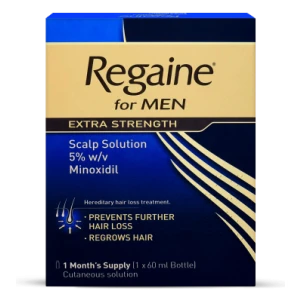Hair loss
Male pattern baldness is the most common type of hair loss, affecting more than 80% of men in the UK during their lifetime. However, women can also be affected by hair loss, with female pattern baldness affecting more than 56% of women over 70 in the UK. It usually starts in a small area but can progress to reveal a large area of the scalp, and it can have a detrimental impact on your appearance and sense of well-being.
However, there are treatments available that can help manage the symptoms of hair loss and help you regain your confidence and self-esteem.
Finasteride
- Slows hair loss
- Promote hair growth
- Available from a UK-registered pharmacy
Propecia (Finasteride)
- The most effective hair loss treatment available
- Promotes hair growth in most cases
- Registered prescribers are on hand
Regaine
- Slows hair loss
- For men and women
- Next-day dispatch from a UK-registered pharmacy
Buy Hair Loss Treatment Online UK
If you've noticed your hairline receding and are concerned about hair loss, there are treatments available that can slow down or halt the process.
At Prescription Doctor, we offer UK-licensed hair loss treatments that can be discreetly delivered to your door.
Understanding Hair Loss
Hair is an integral part of the human integumentary system, composed of keratin, just like skin and nails. The hair growth cycle consists of four phases:
- Anagen phase (3-5 years): Hair grows at a rate of about 1 inch every 2 months.
- Catagen phase (10 days): Hair growth slows down, and the strand prepares for shedding.
- Telogen phase (3 months): The hair detaches from the blood vessel and remains static while the follicle prepares for new hair growth underneath.
- Exogen phase: The hair falls out, making way for new hair, and the cycle restarts.
As we age, the anagen phase becomes longer, resulting in slower hair growth.
What Causes Hair Loss?
Losing some of our hair is normal; we can lose between 50 and 100 hairs every day without even noticing. However, sometimes it can be a sign of a health condition.
Hair loss can be caused by several factors, including:
- Genetics: Hair loss can be hereditary and passed down from your parents, such as male and female pattern baldness or androgenic alopecia.
- Hormones: Declining hormones, like oestrogen in women, can cause hair to thin and fall out.
- Stress: You can lose your hair if you are stressed, as it can be a reaction to emotional or physical shock. This type of hair loss is usually temporary, and your hair will likely grow back on its own.
- Nutrient Deficiencies: If you lack essential nutrients such as iron, vitamin B12, biotin, and vitamin D, it can lead to thinning hair or hair loss.
- Skin Conditions: Conditions such as seborrheic dermatitis and scalp psoriasis can contribute to hair loss.
- Cancer Treatment: Certain cancer treatments, such as chemotherapy or radiotherapy, may cause temporary hair loss; however, your hair can regrow differently.
Many of these causes indicate that hair loss is temporary and your hair will grow back; however, some causes, such as male and female pattern baldness, are permanent. These conditions are usually genetic and often run in families. For example, if one of your parents had it, there’s a strong chance you will too.
What Are the Signs of Hair Loss?
Common signs of hair loss include:
- Thinning hair
- A receding hairline
- Bald patches
Hair Loss Treatments
There are several hair loss treatments available to help manage the symptoms of hair loss in men and women.
Hair Loss Treatments for Men
At Prescription Doctor, we offer the following hair loss treatments for men:
Hair Loss Treatments for Women
At Prescription Doctor, we currently offer Regaine for women in the UK who are experiencing hair loss.
How Quickly Do Hair Loss Tablets Work?
It can take several months for finasteride to show visible effects, but many men notice that their hair loss stops within the first 3 to 6 months.
How Do You Take Hair Loss Tablets?
Finasteride and Propecia tablets are available in 1 mg doses and are typically taken once daily. The tablets can be taken with or without food, and they should be swallowed whole with water. Ideally, you should take finasteride hair loss tablets around the same time each day.
Hair Loss Foam and Solution
Regaine is a topical solution which is applied directly to your scalp. It is available without a prescription, so you can purchase it over the counter. The treatment is suitable for both men and women, and contains the active ingredient minoxidil. Although it's not entirely understood how it stimulates hair growth, it can improve the function of hair follicles and promote new hair growth.
Regaine is available in 2 forms:
- Regaine Solution
- Regaine Foam
Where Can I Buy Hair Loss Treatments?
Prescription and over-the-counter hair loss treatments are available online and from high street pharmacies. If you require a prescription-only medication, you will need to consult a doctor to obtain a prescription or use our online consultation service to receive a private prescription from one of our clinicians.
Can I Buy Hair Loss Treatment Online?
Yes, you can buy hair loss treatments from Prescription Doctor. You’ll need to complete our short online health consultation form, which will be reviewed by one of our clinicians. They will then decide if your chosen hair loss treatment is right for you.
Can I Get Hair Loss Treatment Over-the-Counter?
Yes, some hair loss treatments, such as Regaine for Men and Women, are available to purchase over the counter without a prescription.
Is Hair Loss Treatment Available on the NHS?
Finasteride and Propecia are not available on the NHS for hair loss in the UK. You will need a private prescription for these treatments.
© 2013 - 2025 Al Muhsineen Limited. All Rights Reserved. Registered Pharmacy: 34 Halliwell Road, Bolton BL1 8RL. Registered Office: 254 First Floor, Shearbrow, Blackburn, England, BB1 8DS








